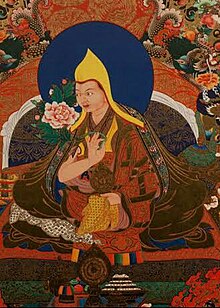Gedun Drupa[1] (Tibetan: དགེ་འདུན་གྲུབ་པ།, Wylie: dge 'dun grub pa; 1391–1474) was considered posthumously to have been the 1st Dalai Lama.[2]
Gedun Drupa
| |||||||||
|---|---|---|---|---|---|---|---|---|---|
དགེ་འདུན་གྲུབ་པ།
| |||||||||

དགེ་འདུན་གྲུབ་པ།
| |||||||||
| Title | 1st Dalai Lama (posthumous designation) | ||||||||
| Personal | |||||||||
| Born | Péma Dorjee 1391 | ||||||||
| Died | 1474 (aged 82–83)
Ü-Tsang, Tibet
| ||||||||
| Religion | Tibetan Buddhism | ||||||||
| Parents |
| ||||||||
| Senior posting | |||||||||
| Successor | Gedun Gyatso | ||||||||
| Chinese name | |||||||||
| Chinese | 根敦朱巴 | ||||||||
| |||||||||
| Tibetan name | |||||||||
| Tibetan | དགེ་འདུན་གྲུབ་པ | ||||||||
| |||||||||
| Original name: Péma Dorjee | |||||||
|---|---|---|---|---|---|---|---|
| Chinese name | |||||||
| Chinese | 巴玛多杰 | ||||||
| |||||||
| Tibetan name | |||||||
| Tibetan | པད་མ་རྡོ་རྗེ་ | ||||||
| |||||||
Gedun Drupa was born in a cow-shed in Gyurmey Rupa near Sakya in the Tsang region of central Tibet, the son of Gonpo Dorjee and Jomo Namkha Kyi, nomadic tribespeople.[3] He was raised as a shepherd until the age of seven. His birth name (according to the Tibetan Buddhist Resource Center, his personal name) was Péma Dorjee (Tibetan: པད་མ་རྡོ་རྗེ་, "Vajra Lotus").
Later he was placed in Narthang Monastery. In 1405, he took his śrāmaṇera (novitiate) vows from the abbot of Narthang, Khenchen Drupa Sherap.[citation needed] When he was 20 years old, in about 1411 received the name Gedun Drupa upon taking the vows of a bhikṣu (monk) from the abbot of Narthang Monastery.[4] Also at this age he became a student of the scholar and reformer Je Tsongkhapa (1357–1419),[5] who some say was his uncle.[6] Around this time he also became the first abbot of Ganden Monastery, founded by Tsongkhapa himself in 1409.[7][better source needed]
By the middle of his life, Gedun Drupa had become one of the most esteemed scholar-saints in the country.[citation needed] Gedun Drupa founded the major monastery of Tashi LhunpoatShigatse, which later became the seat of the Panchen Lamas.[8][volume needed]
Gedun Drupa had no political power. It was in the hands of viceroys such as the Sakyas, the prince of Tsang, and the Mongolian Khagan. The political role of the Dalai Lamas only began with the reign of the 5th Dalai Lama.[citation needed]
He remained the abbot of Tashi Lhunpo Monastery until he died while meditating in 1474 at the age of 84 (83 by Western reckoning).[6]
Tradition states that Palden Lhamo, the female guardian spirit of the sacred lake, Lhamo La-tso, promised the First Dalai Lama in one of her visions "...that she would protect the reincarnation lineage of the Dalai Lamas." Since the time of Gedun Gyatso, who formalized the system, monks have gone to the lake to meditate when seeking visions with guidance on finding the next reincarnation.[9]
The Samding Dorje Phagmo (1422–1455), the highest female incarnation in Tibet,[10] was a contemporary of Gedun Drupa. Her teacher, the Bodongpa Panchen Chogley Namgyal was also one of his teachers; he received many teachings and empowerments from him.[11]
Some of the most famous texts Gedun Drupa wrote were:
| Buddhist titles | ||
|---|---|---|
| Preceded by New creation |
Dalai Lama N/A Posthumously recognized |
Succeeded by |